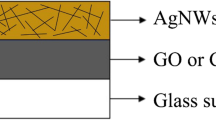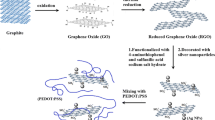Abstract
The one-dimensional (1D) silver nanowires (AgNWs) with high transmittance, high electronic conductivity and two-dimensional (2D) reduced graphene oxide (rGO) both emerge as leading candidates for the development of next-generation transparent conductive films (TCFs). However, the relatively high sheet resistance of rGO and the poor corrosion resistance of AgNWs hinder them to fabricating TCFs independently in practical applications. Here, we used rGO bridging discrete AgNWs, improving conductivity and corrosion resistance of AgNW networks. In this work, firstly, graphene oxide (GO)/AgNW aqueous dispersions were prepared, in which GO played multiple roles as a dispersant to promote the stability of GO/AgNW aqueous dispersions as well. And then the rGO/AgNW hybrid films were successfully fabricated by a facile vacuum filtration followed by dry transfer to polyethylene (PE) substrates and subsequent reduction by hydroiodic acid (HI) vapor at 60 °C. The rGO/AgNW/PE TCF exhibited excellent optical and electrical properties (91.488% at 550 nm and 83.86 Ω/sq). The deposit density of rGO and AgNWs was merely 15.92 mg/m2 and 79.58 mg/m2, respectively.





Similar content being viewed by others
References
Alotaibi F, Tung TT, Nine MJ, Coghlan CJ, Losic D (2018) Silver nanowires with pristine graphene oxidation barriers for stable and high performance transparent conductive films. ACS Appl Nano Mater 1:2249–2260
Badawi Anis AMMZ (2018) Preparation of highly conductive, transparent, and flexible graphene/silver nanowires substrates using non-thermal laser photoreduction. Opt Laser Technol 103:367–372
Cheong H-G, Kim J-H, Song J-H (2015) Highly flexible transparent thin film heaters based on silver nanowires and aluminum zinc oxides. Thin Solid Films 589:633–641
Choi Y, Kim C, Jo S (2018) Spray deposition of Ag nanowire–graphene oxide hybrid electrodes for flexible polymer–dispersed liquid crystal displays. Materials 11:2231
Dongdong Li WLYZ (2018) Printable transparent conductive films for flexible electronics. Adv Mater 30
Du J, Pei S, Ma L, Cheng HM (2014) 25th anniversary article: carbon nanotube- and graphene-based transparent conductive films for optoelectronic devices. Adv Mater 26:1958–1991
F Giannazzo SIGI (2019) Probing the uniformity of hydrogen intercalation in quasi-free-standing epitaxial graphene on SiC by micro-Raman mapping and conductive atomic force microscopy. Nanotechnology 30
Ferhatia H, Djeffal F, Benhaya A (2019) Optimized high-performance ITO/Ag/ITO multilayer transparent electrode deposited by RF magnetron sputtering. Superlattice Microst 129:176–184
Furlani C, Mattogno G, Polzonetti G, Barbieri R, Rivarola E, Silvestri A (1981) Relationship between XPS core binding energies and atomic charge in adducts of SnIV derivatives with pyrazine, and comparison with mössbauer isomer shift data. Inorg Chim Acta 52:23–28
Ghasemi S, Hosseini SR, Mousavi F (2017) Electrophoretic deposition of graphene nanosheets: a suitable method for fabrication of silver-graphene counter electrode for dye-sensitized solar cell. Colloids Surf A Physicochem Eng Asp 520:477–487
Guillaume Genesio JMMC (2019) Recent status on MOF thin films on transparent conductiveoxides substrates (ITO or FTO). New J Chem 42:2351–2363
He L, Tjong SC (2016) Nanostructured transparent conductive films: fabrication, characterization and applications. Mater Sci Eng R Rep 109:1–101
He S, Xu X, Qiu X, He Y, Zhou C (2018) Conductivity of two-dimensional disordered nanowire networks: dependence on length-ratio of conducting paths to all nanowires. J Appl Phys 124:054302
Hsiao S, Tien H, Liao W, Wang Y, Li S, MMa C, Yu Y, Chuang W (2014) A highly electrically conductive graphene–silver nanowire hybrid nanomaterial for transparent conductive films. J Mater Chem C 2:7284
Jie Gao CLLM (2017) Improved thermoelectric performance in flexible tellurium nanowires/reduced graphene oxide sandwich structure hybrid films. J Electron Mater 46:3049–3056
Jinping Zhao SPWR (2010) Efficient preparation of large-area graphene oxide sheets for transparent conductive films. ACS Nano 4:5245–5252
Jiu J, Araki T, Wang J (2014) Facile synthesis of very-long silver nanowires for transparent electrodes. J Mater Chem A 2:6326–6330
Kumar D, Stoichkov V, Brousseau E (2019) High performing AgNW transparent conducting electrodes with a sheet resistance of 2.5 Ω Sq−1 based upon a roll-to-roll compatible post-processing technique. Nanoscale 11:5760–5769
Lai Y, Tai N (2015) One-step process for high-performance, adhesive, flexible transparent conductive films based on p-type reduced graphene oxides and silver nanowires. Acs Appl Mater Int 7:18553–18559
Lee D, Lee H, Ahn Y, Lee Y (2015) High-performance flexible transparent conductive film based on graphene/AgNW/graphene sandwich structure. Carbon 81:439–446
Li QLLZ (2019) Graphene transparent conductive films directly grown on quartz substrates by assisted catalysis of Cu nanoparticles. J Mater Sci 54:10312–10324
Li L, Li W, Jiu J, Suganuma K (2018) Efficient assembly of high-performance reduced graphene oxide/silver nanowire transparent conductive film based on in situ light-induced reduction technology. Appl Surf Sci 459:732–740
Li Y, Yuan X, Yang H, Chao Y, Guo S, Wang C (2019) One-step synthesis of silver nanowires with ultra-long length and thin diameter to make flexible transparent conductive films. Materials 12:401
Liu W, Lu C, Wang X, Tay RY, Tay BK (2015) High-performance microsupercapacitors based on two-dimensional graphene/manganese dioxide/silver nanowire ternary hybrid film. ACS Nano 9:1528–1542
Long Tang JZLD (2018) Coating-free, air-stable silver nanowires for highperformance transparent conductive film. Nanotechnology 29
Naghdi S, Rhee K, Hui D, Park S (2018) A review of conductive metal nanomaterials as conductive, transparent, and flexible coatings, thin films, and conductive fillers: different deposition methods and applications. COATINGS 8:278
Ning J, Hao L, Jin M, Qiu X, Shen Y, Liang J, Zhang X, Wang B, Li X, Zhi L (2017) A facile reduction method for roll-to-roll production of high performance graphene-based transparent conductive films. Adv Mater 29:1605028
Offeman WSHR (1958) Preparation of graphitic oxide. J Am Chem Soc 80:1339
Qingbin Zheng WHIX (2011) Transparent conductive films consisting of ultralarge graphene sheets produced by Langmuir–Blodgett assembly. ACS Nano 7:6039–6051
Qiu T, Luo B, Liang M, Ning J, Wang B, Li X, Zhi L (2015) Hydrogen reduced graphene oxide/metal grid hybrid film: towards high performance transparent conductive electrode for flexible electrochromic devices. CARBON 81:232–238
Ricciardulli AG, Yang S, Wetzelaer GAH, Feng X, Blom PWM (2018) Hybrid silver nanowire and graphene-based solution-processed transparent electrode for organic optoelectronics. Adv Funct Mater 28:1706010
Rosli NN, Ibrahim MA, Ahmad Ludin N, Mat Teridi MA, Sopian K (2019) A review of graphene based transparent conducting films for use in solar photovoltaic applications. Renew Sust Energ Rev 99:83–99
Sharma S, Shriwastava S, Kumar S (2018) Alternative transparent conducting electrode materials for flexible optoelectronic devices. Opto-Electron Rev 26:223–235
Songfeng Pei QWKH (2018) Green synthesis of graphene oxide by seconds timescale water electrolytic oxidation. Nat Commun 9
Tugba Camic B, Oytun F, Hasan Aslan M, Jeong Shin H, Choi H, Basarir F (2017) Fabrication of a transparent conducting electrode based on graphene/silver nanowires via layer-by-layer method for organic photovoltaic devices. J Colloid Interface Sci 505:79–86
Xuesong Li LCAR (2016) Synthesis of graphene films on copper foils by chemical vapor deposition. Adv Mater 28:6247–6252
Yahui Gao WWNS (2017) Fabrication of highly flexible transparent conductive film with a sandwich-structure consisted of graphene/silver nanowire/graphene. J Mater Sci Mater Electron 28:17031–17037
Yasin Altin MTİB (2016) Solution-processed transparent conducting electrodes with graphene, silver nanowires and PEDOT:PSS as alternative to ITO. Surf Coat Tech 302:75–81
Yong Wei SCFL (2015) Hybrids of silver nanowires and silica nanoparticles as morphology controlled conductive filler applied in flexible conductive nanocomposites. Compos Part A 73:195–203
Zhang P, Wyman I, Hu J, Lin S, Zhong Z, Tu Y, Huang Z, Wei Y (2017) Silver nanowires: synthesis technologies, growth mechanism and multifunctional applications. Mater Sci Eng B 223:1–23
Ziwen Liu YJSZ (2018) Rapid preparation of conductive transparent films via solution printing of graphene precursor. Thin Solid Films 657:24–31
Funding
The authors gratefully acknowledge the financial support offered by the National Natural Science Foundation of China (Grant Nos. 51371129 and 1114,226) and lab of green platemaking and standardization for flexographic printing (Grant No. ZBKT201903).
Author information
Authors and Affiliations
Corresponding author
Ethics declarations
Conflict of interest
The authors declare that they have no conflicts of interest.
Additional information
Publisher’s note
Springer Nature remains neutral with regard to jurisdictional claims in published maps and institutional affiliations.
Rights and permissions
About this article
Cite this article
Zhang, R., Liao, Y., Zhou, Y. et al. A facile and economical process for high-performance and flexible transparent conductive film based on reduced graphene oxides and silver nanowires. J Nanopart Res 22, 39 (2020). https://doi.org/10.1007/s11051-020-4751-7
Received:
Accepted:
Published:
DOI: https://doi.org/10.1007/s11051-020-4751-7




